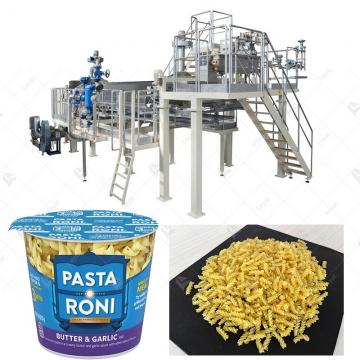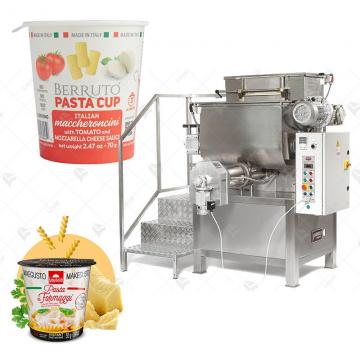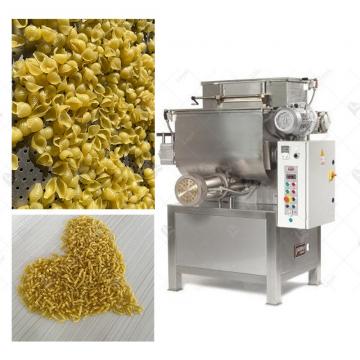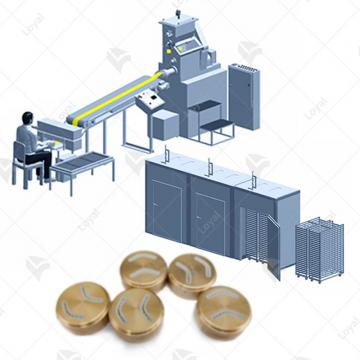
- Shandong Loyal Industrial Co.,Ltd.
- SHORT-CUT PASTA PRODUCTION LINE LONG-CUT PASTA PRODUCTION LINE INSTANT PASTA PRODUCTION LINE
Home> Company News> The Ultimate Guide to Instant Pasta Cup production line in 2024

The Ultimate Guide to Instant Pasta Cup production line in 2024
2024-03-28 12:17:10In today's fast-paced world, convenience is key, especially when it comes to food choices. The demand for quick and easy meal solutions has been on the rise, prompting the emergence of innovative products such as instant pasta cup production line. These convenient options have become a popular choice among consumers seeking a hassle-free way to enjoy a delicious meal on the go. In this guide, we'll delve into the intricacies of instant pasta cup production line and explore why efficient production lines are crucial in meeting the ever-growing market demand.
As lifestyles become busier and time becomes increasingly scarce, consumers are constantly seeking ways to streamline their meal preparation process. Instant pasta cups offer a convenient solution, allowing individuals to enjoy a satisfying meal with minimal effort and time investment. Whether it's a quick lunch at the office or a late-night snack at home, these portable cups provide a convenient option for satisfying hunger cravings on the fly.
Understanding the Market Landscape
1. Health and Wellness: With increasing health consciousness among consumers, there is a growing demand for healthier instant food options. Manufacturers are responding by incorporating natural ingredients, reducing additives, and offering gluten-free, organic, and low-sodium alternatives in instant pasta cups. Health-centric variations, such as whole grain pasta and vegetable-based sauces, are gaining popularity as consumers seek nutritious yet convenient meal solutions.
2. Global Flavor Exploration: Consumers are embracing a diverse range of flavors and cuisines, driving the innovation of exotic and international-inspired instant food options. Manufacturers are introducing instant pasta cup varieties featuring flavors from around the world, such as Thai curry, Mediterranean pesto, Mexican salsa, and Japanese ramen. This trend reflects the increasingly adventurous palates of consumers seeking exciting culinary experiences in convenient formats.
3. Sustainable Packaging Solutions: Environmental sustainability has become a significant concern for consumers, prompting manufacturers to adopt eco-friendly packaging solutions for instant pasta cups. Biodegradable materials, recyclable packaging, and minimalistic designs are increasingly prevalent, aligning with consumer preferences for environmentally responsible products. Brands are leveraging sustainable packaging as a competitive advantage, appealing to eco-conscious consumers and reducing their environmental footprint.
4. Convenience Redefined: As busy lifestyles become the norm, consumers are prioritizing convenience without compromising on taste, quality, or nutrition. Instant pasta cups offer a convenient meal option that can be prepared quickly and enjoyed anywhere, catering to the needs of time-strapped individuals, students, office workers, and families. Portability, microwaveability, and single-serve portions contribute to the convenience factor, making instant pasta cups a convenient solution for on-the-go consumption.
5. Customization and Personalization: Personalization is emerging as a key trend in the instant food industry, with consumers seeking customizable options to suit their individual preferences and dietary requirements. Manufacturers are introducing customizable instant pasta cup offerings, allowing consumers to adjust seasoning levels, add protein or vegetable toppings, or choose from a variety of pasta shapes and sauces. This trend enhances consumer engagement, fosters brand loyalty, and satisfies the desire for personalized dining experiences.
Market Analysis of Instant Pasta Cup Consumption
In today's fast-paced world, instant pasta cup production lines have become increasingly popular due to their convenience and ease of preparation. Leveraging cutting-edge instant pasta technology, these production lines are revolutionizing the way we consume pasta. One key aspect driving the success of these lines is the comprehensive market analysis of instant pasta cup consumption
Consumers are constantly seeking quick and convenient meal solutions to fit their busy lifestyles, making instant pasta cups an attractive option. Market analysis reveals a significant uptick in the consumption of instant pasta cups, with consumers appreciating the convenience and variety they offer. This trend is further fueled by the growing demand for on-the-go meal options and the rising preference for ready-to-eat foods.
The integration of instant pasta technology into production lines allows manufacturers to meet this demand efficiently. Advanced machinery ensures the swift and precise production of instant pasta cups, from cooking and packaging to distribution. This streamlined process not only enhances productivity but also maintains the quality and freshness of the final product.
Moreover, the emergence of instant pasta ready-meal production lines caters to the evolving needs of consumers who seek complete meal solutions. These production lines enable the assembly of instant pasta cups with complementary side dishes, sauces, and toppings, offering a convenient and satisfying dining experience.
In conclusion, the rise of instant pasta cup production lines driven by innovative instant pasta technology reflects the evolving preferences of modern consumers. With a thorough market analysis of instant pasta cup consumption, manufacturers can capitalize on this trend and deliver convenient, high-quality products that meet the demands of today's on-the-go lifestyle.
Competitor Analysis and Key Players in the Market
The landscape of instant pasta cup production is fiercely competitive, with several key players vying for market share. Established brands and new entrants alike are investing heavily in research and development to innovate their instant pasta technology and production processes. Notable competitors include multinational food corporations, innovative startups, and private label manufacturers. Key players in the market are continuously striving to differentiate their offerings through unique flavors, packaging designs, and sustainable practices.
Amidst this competitive environment, companies are leveraging technological advancements to streamline production, enhance product quality, and meet the ever-evolving demands of consumers. Automation, robotics, and smart manufacturing solutions are revolutionizing the instant pasta ready-meal production line, enabling faster production cycles, greater precision, and improved cost efficiency.
Components of an Efficient Production Line
An efficient instant pasta cup production line comprises several key components, each playing a crucial role in ensuring smooth operations and high-quality output.
1. Mixing and Blending System:
The first step in the production process involves mixing and blending the ingredients to create the pasta dough. Advanced mixing systems ensure uniformity in texture and flavor, contributing to the consistency of the final product.
2. Extrusion and Shaping Equipment:
Once the dough is prepared, it is passed through extrusion and shaping equipment to form the desired pasta shapes. This equipment utilizes precision engineering to mold the dough into uniform shapes, such as spirals, shells, or tubes.
3. Cooking and Cooling Units:
After shaping, the pasta undergoes cooking to achieve the perfect texture. Cooking units regulate temperature and cooking time to ensure optimal results. Subsequently, the pasta is rapidly cooled to prevent overcooking and maintain freshness.
4. Sauce and Seasoning Dispensers:
To enhance flavor and convenience, automated sauce and seasoning dispensers are integrated into the production line. These dispensers accurately portion and distribute sauces, spices, and seasonings, allowing for customizable flavor profiles.
5. Packaging Machinery:
The final step involves packaging the cooked pasta into individual cups, ready for consumption. Packaging machinery seals the cups securely, preserving freshness and extending shelf life. Additionally, labeling and coding systems ensure product traceability and compliance with regulatory standards.
The Significance of Integration and Synchronization in Instant Pasta Cup Production Lines
In the realm of food production, efficiency and precision are paramount. This is particularly true in the domain of instant pasta cup production lines, where integration and synchronization play pivotal roles in ensuring smooth operations and high-quality output.
Integration is the seamless coordination of various components and processes within the production line. From the initial stages of ingredient mixing to the final packaging phase, every step must be integrated to work cohesively. This ensures that the production line functions efficiently without any bottlenecks or delays. For instance, an integrated system can automatically adjust ingredient quantities based on real-time data, optimizing the production process and minimizing waste.
Similarly, synchronization refers to the precise timing and coordination of different tasks within the production line. Each component must work in harmony with the others to maintain a continuous flow of production. For example, the mixing, extrusion, and shaping processes must be synchronized to ensure uniformity and consistency in the final product. Any deviation from the synchronized schedule can lead to inefficiencies and compromise product quality.
The instant pasta technology employed in these production lines further emphasizes the importance of integration and synchronization. Advanced machinery and automation allow for rapid cooking and cooling processes, ensuring that the pasta retains its texture and flavor. By integrating cutting-edge technology into the production line, manufacturers can enhance efficiency, reduce processing times, and meet the growing demand for instant pasta products.
Moreover, the emergence of instant pasta ready-meal production lines underscores the need for seamless integration and synchronization. These production lines not only handle the pasta itself but also incorporate sauces, seasonings, and other ingredients to create complete ready-to-eat meals. Without proper integration and synchronization, achieving consistency and flavor balance across various components would be challenging.
In conclusion, the instant pasta cup production line process relies heavily on integration and synchronization to deliver high-quality products efficiently. By prioritizing these aspects, manufacturers can streamline operations, minimize costs, and meet consumer demand for convenient and delicious instant pasta options. As technology continues to advance, ensuring seamless integration and synchronization will remain essential for success in the competitive food industry landscape.
Emerging Technologies in Instant Pasta Cup Production
In recent years, the instant pasta cup production line has witnessed a revolutionary transformation thanks to emerging technologies. These advancements have not only streamlined the manufacturing process but also enhanced the quality and variety of instant pasta cups available in the market.
One of the key innovations in the instant pasta cup production line is the utilization of automated mixing and cooking systems. These systems integrate precision-controlled equipment to ensure the perfect blend of ingredients and optimal cooking conditions for each pasta cup. By automating these processes, manufacturers can achieve consistency in taste and texture while minimizing production time and costs.
Moreover, the incorporation of smart packaging solutions has significantly improved the shelf life and convenience of instant pasta cups. Advanced packaging materials and techniques, such as modified atmosphere packaging (MAP) and vacuum sealing, help preserve the freshness of the pasta and extend its expiration date. Additionally, smart packaging features such as QR codes or NFC tags enable consumers to access detailed product information and cooking instructions with a simple scan, enhancing the overall user experience.
Furthermore, the implementation of data analytics and predictive maintenance technologies has revolutionized the maintenance and optimization of instant pasta cup production lines. By collecting and analyzing real-time data from sensors installed throughout the production line, manufacturers can identify potential issues before they escalate into costly downtime. Predictive maintenance algorithms can predict equipment failures and schedule maintenance activities proactively, ensuring uninterrupted production and maximizing operational efficiency.
In addition to these technological advancements, the instant pasta cup production line has also benefited from innovations in ingredient sourcing and formulation. Manufacturers are increasingly exploring alternative ingredients such as whole grains, legumes, and plant-based proteins to meet the growing demand for healthier and more sustainable food options. Furthermore, advancements in food processing technologies, such as extrusion and freeze-drying, have enabled the creation of a diverse range of pasta shapes and textures, catering to consumers' evolving preferences.
In conclusion, the instant pasta cup production line has undergone a significant transformation due to emerging technologies, ranging from automated manufacturing systems to smart packaging solutions and data-driven maintenance practices. These advancements have not only improved the efficiency and quality of production but have also expanded the range of options available to consumers, making instant pasta cups a convenient and appealing choice for modern lifestyles.
Quality Control and Food Safety Measures
In the realm of instant pasta cup production line and instant pasta technology, ensuring the highest standards of quality and safety is paramount. This is not only a matter of meeting regulatory requirements but also a commitment to delivering excellence to consumers.
At every stage of the instant pasta ready-meal production line, rigorous quality control protocols are implemented. Beginning with the selection of raw materials, only the finest ingredients that meet strict quality criteria are chosen. These ingredients undergo thorough inspection and testing to guarantee their freshness, purity, and suitability for the production process.
Once the ingredients are approved for use, attention shifts to the production phase. Advanced technologies are employed to maintain precision and consistency in every aspect of manufacturing. From mixing and shaping to cooking and packaging, each step is carefully monitored to ensure uniformity and adherence to predefined standards.
Throughout the production process, stringent quality checks are conducted at regular intervals. These checks encompass various parameters such as texture, taste, color, and nutritional content. Any deviation from the established benchmarks prompts immediate corrective actions to rectify the issue and prevent substandard products from reaching the market.
In addition to maintaining quality, an unwavering focus is placed on food safety. Compliance with stringent regulations and certifications is non-negotiable. Stringent hygiene practices are observed in the production facility, with regular sanitation schedules and personnel training programs in place to mitigate the risk of contamination.
Moreover, traceability measures are implemented to track the journey of each product from production to distribution. This enables swift and targeted responses in the event of any safety concerns or product recalls, safeguarding both consumers and the brand's reputation.
In conclusion, the instant pasta cup production line operates under a rigorous framework of quality control and food safety measures. By upholding high standards and complying with regulations, manufacturers ensure that every instant pasta product that reaches consumers is not only delicious but also safe and trustworthy.
Evaluation of the Costs Associated with Setting up an Instant Pasta Cup Production Line
In the rapidly evolving landscape of food production technology, the emergence of instant pasta technology has revolutionized the convenience food industry. One of the pivotal components facilitating this transformation is the instant pasta cup production line. This article undertakes a comprehensive evaluation of the costs associated with establishing such a production line, shedding light on the financial considerations crucial for stakeholders in the ready-meal sector.
First and foremost, the instant pasta cup production line encompasses sophisticated machinery and equipment tailored to streamline the manufacturing process. These include but are not limited to mixers, extruders, and packaging units, each optimized for efficient production. The initial capital investment in acquiring this machinery constitutes a significant portion of the setup costs.
Furthermore, the integration of instant pasta technology into the production line necessitates specialized equipment capable of rapid pasta cooking and dehydration. These advanced technologies ensure the preservation of taste and texture while extending the product's shelf life, thereby enhancing its market competitiveness. However, the acquisition and installation of such technology contribute substantially to the overall setup expenditure.
In addition to equipment procurement, expenses associated with facility setup and infrastructure cannot be overlooked. A dedicated production facility equipped with requisite utilities such as water, electricity, and ventilation is essential for seamless operations. Moreover, compliance with regulatory standards and obtaining necessary certifications entail additional costs, albeit indispensable for ensuring product quality and consumer safety.
Apart from capital expenditures, operational costs constitute a significant aspect of the evaluation. These encompass expenditures related to raw materials procurement, labor wages, and maintenance of machinery. The efficient utilization of resources and optimization of production processes are imperative for minimizing operational costs and maximizing profitability.
Considering the aforementioned factors, a comprehensive cost-benefit analysis is imperative for prospective investors contemplating entry into the instant pasta ready-meal production line market. While the initial setup costs may appear substantial, the potential for long-term profitability and market growth cannot be underestimated. Moreover, strategic considerations such as market demand, competition, and technological advancements play a pivotal role in shaping investment decisions.
Predictions for the Future of the Instant Pasta Cup Market
In the fast-paced realm of convenience foods, the instant pasta cup production line stands as a pivotal innovation. With the ever-increasing demand for quick, easy-to-prepare meals, the instant pasta technology has revolutionized the way consumers approach mealtime. As we delve into the future of the food industry, it's evident that the trajectory of the instant pasta ready-meal production line will play a significant role in shaping consumer preferences and market dynamics.
One of the most striking predictions for the future of the instant pasta cup market is the exponential growth it is poised to experience. As consumers continue to prioritize convenience without compromising on quality, the demand for instant pasta technology will soar. This demand will fuel investments in research and development, leading to enhanced production capabilities and more innovative product offerings.
Moreover, with advancements in food processing technology, the instant pasta cup production line will become more efficient and sustainable. Manufacturers will increasingly focus on optimizing energy usage and reducing waste throughout the production process. This commitment to sustainability will not only appeal to environmentally conscious consumers but also align with evolving regulatory standards.
Another key trend shaping the future of the instant pasta cup market is the diversification of product offerings. As consumer tastes become more eclectic and health-conscious, manufacturers will introduce a wider range of flavors and formulations to cater to diverse preferences. From traditional pasta dishes to gluten-free and plant-based options, the instant pasta ready-meal production line will evolve to accommodate varying dietary needs and lifestyle choices.
Furthermore, technological innovations such as automation and artificial intelligence will revolutionize the production process, driving efficiency and cost-effectiveness. This automation will streamline operations and minimize human error, ensuring consistency in product quality across batches. Additionally, AI-driven algorithms will enable manufacturers to analyze consumer data and trends, facilitating targeted marketing strategies and product development initiatives.
In conclusion, the future of the instant pasta cup market is bright and promising. With advancements in instant pasta technology and production capabilities, coupled with shifting consumer preferences towards convenience and sustainability, the industry is primed for continued growth and innovation. By embracing these trends and staying ahead of the curve, manufacturers can capitalize on the lucrative opportunities presented by the evolving landscape of the convenience food sector.
Opportunities for Innovation and Growth in Instant Pasta Cup Production Line Technology
In today's fast-paced world, convenience and efficiency are paramount in the food industry. One such innovation that has gained significant traction is the instant pasta cup production line. This revolutionary technology streamlines the process of producing instant pasta, offering consumers a quick and hassle-free meal option.
The instant pasta technology behind these production lines allows for the rapid creation of individual servings of pasta that can be prepared in a matter of minutes. By combining the latest advancements in food processing and packaging, manufacturers can meet the demands of busy consumers who are constantly on the go.Moreover, the instant pasta ready-meal production line enables companies to capitalize on the growing trend of ready-to-eat meals. With more people leading busy lifestyles, there is a high demand for convenient food options that do not compromise on taste or quality. These production lines allow manufacturers to meet this demand by offering delicious and nutritious pasta meals that can be enjoyed anytime, anywhere.
One of the key opportunities for innovation and growth in this industry lies in the development of new and exciting pasta flavors and recipes. By leveraging advancements in food science and technology, manufacturers can experiment with different ingredients and flavor profiles to create unique and enticing products that cater to a diverse range of tastes and preferences.Furthermore, there is ample room for improvement in the efficiency and sustainability of instant pasta cup production lines. As consumers become more environmentally conscious, there is a growing demand for eco-friendly packaging solutions and manufacturing processes. By investing in research and development, companies can develop innovative packaging materials and production techniques that minimize waste and reduce the industry's carbon footprint.
In addition to product innovation, there is also potential for growth through strategic partnerships and collaborations. By forging alliances with suppliers, distributors, and retailers, manufacturers can expand their reach and penetrate new markets more effectively. This not only allows for increased sales and revenue but also fosters greater brand visibility and consumer awareness.
References
Here are five authoritative websites on instant pasta production lines:
1. Food Processing Technology: (https://www.foodprocessing-technology.com/)
2. Food Engineering Magazine: (https://www.foodengineeringmag.com/)
3. Packaging World: (https://www.packworld.com/)
4. Global Food Technology: (https://www.globalfoodtechnology.com/)
5. Food Manufacture: (https://www.foodmanufacture.co.uk/)
FAQs: Frequently Asked Questions About Instant Pasta Cup Production Line
1. What is an instant pasta cup production line?
An instant pasta cup production line is a system of machinery and equipment designed to automate the process of producing individual servings of pasta that are conveniently packaged in cups for immediate consumption.
2. How does an instant pasta cup production line work?
The production line typically includes equipment for mixing and kneading dough, shaping pasta, cooking, drying, seasoning, and packaging. These processes are automated to ensure efficiency and consistency in the final product.
3. What types of pasta can be produced using an instant pasta cup production line?
Various types of pasta, including spaghetti, penne, fusilli, and macaroni, can be produced using an instant pasta cup production line. The flexibility of the equipment allows for customization according to consumer preferences.
4. Are instant pasta cups shelf-stable?
Yes, instant pasta cups are designed to have a long shelf life, making them suitable for storage at room temperature. The packaging materials and sealing techniques used help preserve the freshness and flavor of the pasta over time.
5. Are instant pasta cups suitable for vegetarians and vegans?
Many instant pasta cup varieties are available in vegetarian and vegan options, catering to individuals with dietary restrictions or preferences. Ingredients such as vegetables, herbs, and plant-based proteins are commonly used to create flavorful and nutritious options.

 Instant Pasta Production Line
Instant Pasta Production Line INSTANT PASTA CUP PRODUCTION LINE
INSTANT PASTA CUP PRODUCTION LINE PRECOOKED PASTA PRODUCTION LINE
PRECOOKED PASTA PRODUCTION LINE Dry Pasta Production Line
Dry Pasta Production Line